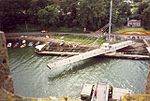Aber Afon Seiont
Afon Seiont is a Site of Special Scientific Interest (or SSSI) in West Gwynedd, Wales. It is protected by law and has been designated as a Site of Special Scientific Interest since July 1997 in an attempt to protect rare or unique features or species within it. The site has an area of 6.4 hectares and is managed by Natural Resources Wales. This site is designated due to its geological qualities. In Wales, geological sites range from quarries to rocky outcrops and massive sea-cliffs. 30% of SSSIs in Wales are notified for geological and geomorphological features. River Seiont is a small river which flows to the sea at Caenarfon, North Wales. Gwynedd County Council and Caernarfon Harbour Trust own this site, with no public access. The west river bank, and also in a past river cliff located 200m inland, is of particular interest for strata. The exposed rocks include the Arenig and overlying Llanvirn series.
Excerpt from the Wikipedia article Aber Afon Seiont (License: CC BY-SA 3.0, Authors).Aber Afon Seiont
Coed Helen Lane,
Geographical coordinates (GPS) Address Nearby Places Show on map
Geographical coordinates (GPS)
| Latitude | Longitude |
|---|---|
| N 53.134121 ° | E -4.2740644 ° |
Address
Coed Helen Lane
Coed Helen Lane
LL54 5RS , Caernarfon
Wales, United Kingdom
Open on Google Maps









